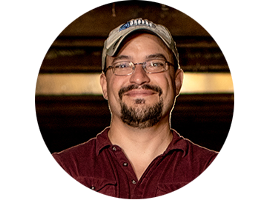Maritime Field School 2006
Contributions by Wayne Abrahamson, Nickie Hamann, Brian Adams, Jim Collis, and Kendra Kennedy
The University of West Florida (UWF)'s 2006 summer field school incorporated both remote sensing and diver investigations of magnetic anomalies and known wreck sites in Pensacola Bay and beyond. This summer's activities included: an examination of several wreck sites in Pensacola Bay, including three previously unknown vessels discovered during the 2005 field school; diving on and recording a nineteenth century side-wheel steamboat in Alabama; remote sensing and diver investigations in an area suspected to contain colonial Spanish vessels lost in the 1559 hurricane; and examinations of the maritime landscapes in Navy Cove (a historic careening area) and in East Bay (which was thought to include both prehistoric and historic underwater sites).
Field school began with a week of scientific dive training. Dive Safety Officers Lloyd Oubre and Paul Sjordal instructed the students in the regulations and safety procedures of scientific diving and the UWF marine services center. The DSOs also conducted scientific dive certification at the UWF pool and in an open water environment - Vortex Springs, Florida. All students successfully completed certification.
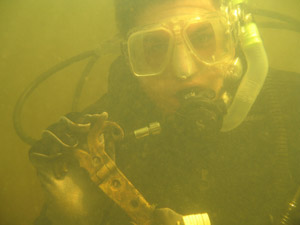
Whiskey and Window Panes: The story of an Alabama Side-wheel Steamboat
After scientific dive training, work began on a sidewheel steamboat wreck in Alabama. The wreck is located in a riverine environment and dates to the nineteenth century. Though it lies at a 44 degree angle, the steamboat is incredibly well-preserved. Supervisors and students focused on the forward part of the ship and the machinery during the first few weeks of investigation. Detailed scale drawings were made of the bow, stem, planking, guard frames, boiler, hatches, and walking beam. Later work focused on features in the stern of the ship, such as the rudder and sternpost. Though the name of the steamboat is not yet known, a plaque was discovered on part of the engine machinery that may aide in its identification. Artifacts, when discovered, were left in situ and included window glass and hinges, among other items. Local residents were very interested in the investigation of the vessel and provided invaluable information on the history of the area and the steamboat, which may have carried tourists and alcohol up and down river during its period of operation. Over the course of the summer, students and supervisors returned to the wreck many times to record additional information.
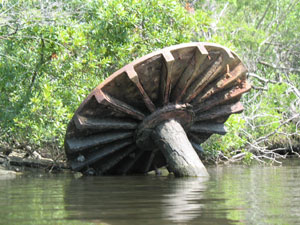
Even after the summer ended, work on the Alabama wreck continued and the ship continues to be an integral part of UWF’s educational platform on maritime archaeology. The ship is very well preserved, structurally sound, and in an environment that is conducive to training in maritime archaeology. All of these factors, combined with the outstanding leadership provided by the graduate supervisors and faculty of UWF, have provided an educational experience for all involved and has been recognized by, not only the local community, but also the Alabama Historical Commission. Field school students, supervisors, and UWF faculty will return to the Alabama wreck during the summer of 2007.
Since the maritime field school, UWF staff and students have visited the Alabama Wreck several times in order to gather more information for the on-going site plan and to obtain data that can be used to identify the ship and its original purpose. UWF graduate student Wayne Abrahamson, who is studying this wreck for his thesis work, has discovered that the ship was built around 1870, in New York City, and operated well into the 1920s, spending over half of its life here in the Southeast. Though work on the wreck during the 2006 field school proved to be an excellent experience, the 2007 field school offers the promise of an even more interesting and productive summer.
~Wayne Abrahamson
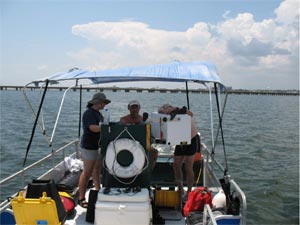
Pensacola Bay Remote Sensing
During the summer of 2006, field school participants also completed remote sensing surveys with a magnetometer and side-scan sonar in Pensacola waters, including areas in Blackwater Bay, Old English Cove, Bayou Chico, the Pensacola Waterfront, and Pensacola Bay. Promising anomalies in each of the areas were ground-truthed to determine the nature of the disturbance. When students dove on one of the anomalies near the Emanuel Point Shipwreck, excavated by UWF in prior field seasons, they identified ballast stone on an otherwise flat, sandy bottom.
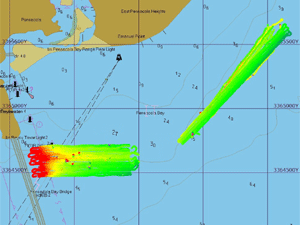
Upon further investigation with dredging equipment, students found deeply buried artifacts, including lead sheathing. Since lead sheathing was used in ship construction for centuries, its presence does not provide the specific age of the anomaly, but it is compatible with the type of sheathing that would have been used to outfit ships of the 1559 Luna expedition. Work on this anomaly familiarized students with some techniques of underwater excavation, including dredging and metal detecting. This work will continue during the 2007 field school in hopes of determining the identity, age, and nationality of the anomaly.
~Nickie Hamann
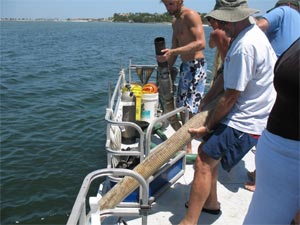
Deadman's Island Maritime Landscape
In addition to work in Alabama and around the Pensacola waterfront, students and faculty conducted investigations of Deadman's Island in Pensacola Bay near Gulf Breeze, Florida. These investigations included remote sensing with side-scan sonar and magnetometer. Several anomalies were discovered as a result of these investigations and dredging was conducted on the most likely targets.
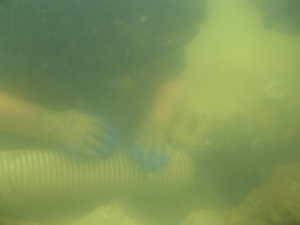
The uncovered resources included remnants of several wrecks, remains associated with the marine railway that was located on the island, and some features that have yet to be identified. All features were recorded manually and surveyed with a Total Station. Information gathered at Deadman's Island will be used by UWF graduate student Krista Jordan for her graduate thesis as well as in future investigations of this dynamic, evolving maritime landscape near Pensacola.
~Brian Adams
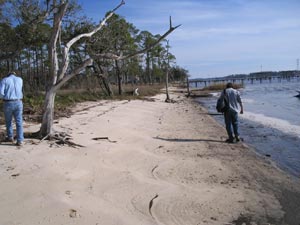
East Bay
UWF field school students also examined two established inundated sites on the northwestern coast of East Bay during the 2006 summer season. The first of these is 8SR234, a mid-nineteenth-century homestead site that was inundated at least six decades ago; the second is 8SR201, a late-Archaic Native American site reported to contain lithics of a type not often found in this part of Florida.
The 19th-century site, found in the northern corner of Chimney Cove, was identifiable from the remains of a chimney that was known to have still been standing within the tidal zone in the 1930s. The remains of the chimney were mapped and students used a hand-held metal detector to conduct remote sensing in this zone, noting the location of each anomaly by baseline and offset. Later, students returned to test run the new underwater dredge system and to excavate several of the targets found on the earlier survey.
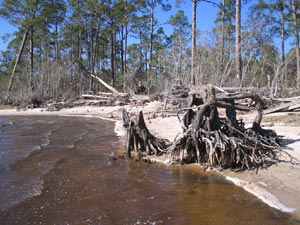
The Native American site gave students opportunities to gain precise mapping experience and conduct statistical sampling over a large area. 8SR201 was reported to the state of Florida in the 1980s and was recognized as a potentially important site containing chert tools made from material brought to East Bay from at least 100 miles away. Throughout the summer, small groups of students sank almost 250 1-meter-deep cores over a 3000-square-meter area just offshore to the south of the Chimney Cove site in an attempt to locate this unusual site. Though the site was not located, students gained valuable survey experience in East Bay.
~Jim Collis
Summary
The 2006 maritime field school provided students with experience in recording and excavation techniques in various underwater environments, from the clear Gulf of Mexico to the limited visibility of the Blackwater river. Students drew scale drawings of the artifacts that they encountered, including the ships themselves, and mapped those elements into larger site plans. In addition, students gained experience in the use of remote sensing equipment -- magnetometer, side-scan sonar, and metal detectors -- in maritime archaeology. The proximity of a wide variety of maritime environments and cultural resources that provides for a wide-range of experiential learning activities makes Pensacola an ideal site from which to base a maritime field school. The 2006 maritime field school was no exception.
Thanks to UWF professors Dr. John Bratten and Greg Cook, volunteer Harv Dickey (mag guru), field director Wayne Abrahamson, and supervisors Nickie Hamann, Brian Adams, and Jim Collis for a great field season!



